An Unfortunate Man
Published in 18th–19th - Century History, Features, Issue 2 (Summer 1998), The United Irishmen, Volume 6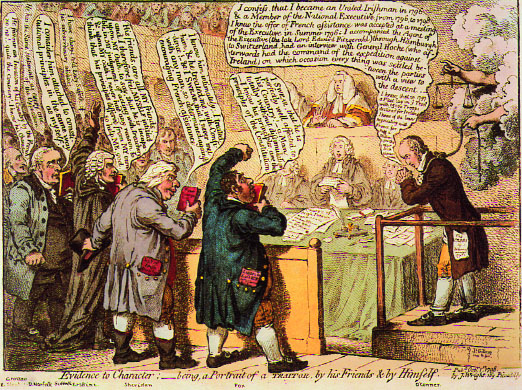
Leading Whigs, led by Charles J. Fox (left), give character evidence at the trial of Arthur O’Connor (right) in James Gillray’s vicious caricature. (British Museum)
On 7 June 1798, Father James Coigly, a shadowy United Irishman from County Armagh, was hanged on Pennington Heath. On hearing this news in Paris, Theobald Wolfe Tone, no friend of priests and of this one in particular, wrote ‘if ever I reach Ireland and…we establish our liberty, I will be the first to propose a monument to his memory’. Nonetheless, as we commemorate the bicentenary of the Rebellion, Coigly remains amongst the forgotten of that year and few of the period’s radicals cry out so loudly for re-examination.
Family background
James Coigly, the second son of James Coigly and Louisa Donnelly, was born in the parish of Kilmore in County Armagh in August 1761. The family lived in moderate circumstances, but like other Catholic families of the region—the Teelings, Coyles, Maginnisses and McDonnells—they provided leadership, and were a reminder of earlier dispossession and a harbinger of the late eighteenth-century Catholic revival. Armagh was perhaps the most complex county in Ireland. Not alone was it the most densely populated, but its religious demography reflected the successive waves of planters and migrants which had given the county its unique character. In the south, the Gaelic, Catholic survival was most pronounced, enabling Coigly to boast that ‘not one of the plundering settlers who enslaved [his] country appears on the list of [his] ancestors’. This sense of history pervades Coigly’s The Life of the Rev. James Coigly and An Address to the People of Ireland, as written by himself during his confinement in Maidstone Gaol (1798); he makes extravagant claims for his family’s bravery in the Confederate and Jacobite periods, while the entire text is peppered with historical allusions.
Little is known of Coigly’s life prior to his ordination at Dungannon, in January 1785. It is believed that he attended the Free School at Dundalk, where he received a classical education, after which, he apparently lived for a number of years with his parish priest.
![London Corresponding Society, alarm'd [by news of the arrest of Coigley and O'Connor], Vide. Guilty Consciences by James Gillray. (British Museum)](/wp-content/uploads/2013/02/An-Unfortunate-Man-2.jpg)
London Corresponding Society, alarm’d [by news of the arrest of Coigley and O’Connor], Vide. Guilty Consciences by James Gillray. (British Museum)
‘Systematic insubordination’
Coigly’s arrival in Paris on 8 June 1785, marked the beginning of a turbulent stay in the French capital. Having applied unsuccessfully for a burse at the College, Coigly took the unprecedented step of initiating legal proceedings against his superior, John Baptist Walsh, claiming that the scholarship, established in 1682 for the education of students of the Maginn, Maginniss and O’Neill families, was rightfully his. This conflict was acrimonious, but it was apparently settled to Coigly’s satisfaction. Yet, having achieved one victory over the authorities, he launched a second appeal, this time to restore to students the right to elect their superiors. Coigly may have celebrated his continuous disputes ‘in favour of the poor down-trodden subjects’, but the historian of the diocese of Down and Conor marked ‘this systematic insubordination’ as ‘but a forerunner of his sad and subsequent career, which terminated on the scaffold’.
His second crusade was cut short by the outbreak of revolution in France in the summer of 1789. Coigly remained in Paris until 12 October. By that time Louis XVI had been brought back from Versailles by the women of Paris and within the National Assembly clerical members were shouted down. On the streets of Paris this opposition was more tangible and Coigly, having ‘narrowly avoided being lanternized’ or hung by the crowd, decided to flee the city.
Promoting ‘an union of the Catholics and Dissenters’
Coigly’s return to Ireland coincided with the peak of the so-called ‘Armagh Troubles’, the one hundred or so incidents which rocked that region between 1784 and 1791. The tensions which characterised the last quarter of the eighteenth century were particularly acute in the county, reflecting national tensions in microcosm. Armagh was the premier volunteering county in Ireland. Commander-in-chief and local grandee, Lord Charlemont, while he was to the fore in the parliamentary movement, strenuously opposed political concessions to Catholics. The Armagh Volunteers were almost entirely Protestant until 1784, but some of the more politically advanced corps had begun to admit Catholics. Yet the penal laws forbade Catholics from bearing arms. In an era when the right to bear arms was the badge of citizenship, this was not simply a security precaution, but a declaration of Protestant ascendancy.
Against this background the predominantly Anglican ‘Peep O’Day Boys’ began their raids on Catholic homes, removing ‘illegally’ held arms, unilaterally enforcing the penal laws, and re-asserting Protestant ascendancy. This initiative met with a determined response from the predominantly Catholic ‘Defenders’. The significant numbers of Presbyterians in the county were more inclined towards radical politics, but were also traditionally anti-Catholic. It was imperative for the Ascendancy, therefore, to prevent a nexus between Catholics and Dissenters; towards this end, the exploitation of sectarian tensions proved a most effective weapon. It is in this context that Coigly’s missions of 1791-93 must be set, as he rode through Ulster attempting to forge ‘an union of the Catholics and Dissenters’.
It is probable that Coigly was a member of the Defenders; he had close kinship links with many of their leaders, while the biographer of the United Irishmen, R.R. Madden, claimed that it was he who introduced Napper Tandy to the Defenders of County Louth. His early involvement with the United Irishmen is less certain but his attempt to promote ‘an union of the Catholics and Dissenters’ was consistent with their programme and these forays mirrored the missionary activities of Wolfe Tone, Samuel Neilson and John Keogh in centres of sectarian conflict in neighbouring County Down.
The best source for the Armagh priest remains his own Life and the documents relating to his trial. While these are retrospective and lacking in objectivity, they clearly reflect Coigly’s immersion in the great radical enterprise of 1792. As Madden observed:
These efforts [of 1791-3] ultimately merged into the designs of the Northern United Irishmen, and Coigly, who appears to have been known to the Belfast leaders, as a person who had great influence over the Defenders… was early sought after to promote the views of the Northern United Irishmen.
The demise of Fitzwilliam’s viceroyalty in early 1795 and with it any hope of constitutional redress raised the political temperature in Ireland. Defenderism had spread beyond Armagh and symptoms of disaffection were to be found in fourteen counties in Ulster, north Leinster and Connacht. In the summer of 1795, Dublin Castle received reports of a growing alliance between Defenders and United Irishmen: the new viceroy Camden was determined to take whatever action was needed to halt this ‘government of terror’. In north Leinster and Connacht, the administration launched a ferocious military campaign under Lord Carhampton while, in Ulster, sectarian tensions were exploited in a cynical, and ultimately successful, attempt to defeat the radical challenge.
Orange terror in Armagh
In Coigly’s Armagh such exploitation was particularly effective. The political conflict which had characterised the county since the early 1780s reached its peak in September 1795 with the Peep O’Day Boy victory at the ‘Battle of the Diamond’ and the consequent formation of the Orange Order. While originally a lower-class initiative, the Verners, Blackers and other local gentry families quickly identified with its counter-revolutionary potential. The Order, which Coigly dismissed as ‘a church and king mob’, served to reassert and defend Protestant Ascendancy against the United Irish and Defender challenge. Operating outside the law, this aggressive group inflicted terror upon the region. William Blacker later described how Orangemen, moved by ‘a spirit of vengeance and retaliation’, resolved to drive the Roman Catholics from the region:
It is true a great proportion of these had taken an active part as Defenders and Persecutors of Protestants; still there were many who were ‘quiet in the land’ and had taken no share in such proceedings, but revenge like love is blind.
Estimates vary but, in the House of Commons, James Verner, referring to reports that as many as 7,000 Catholics had been driven from Ulster, cynically declared ‘whatever the Roman Catholics have suffered they have brought upon themselves’.
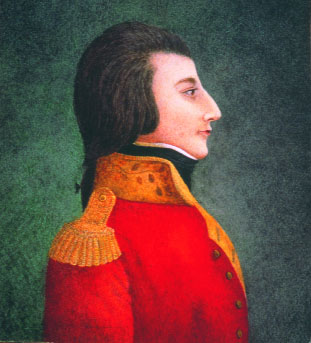
Tone-‘If ever I reach Ireland and…we establish our liberty, I will be the first to propose a monument to his memory.’
The Coiglys were victims of the persecution; their home was ransacked in one attack, which resulted in the destruction of the invaluable historical sources assembled by the priest. This was followed by an assault on his brother’s home, which disrupted the linen business which had ‘kept some hundred hands at work’.
At first the authorities in Dublin and London were sceptical about the Order, but in time they came to regard this lawless faction as a vital weapon in the fight against rebellion. As Thomas Knox, the military commander in mid-Ulster, put it in August 1796:
We must to a certain degree uphold them, for with all their licentiousness, on them we must rely for the preservation of our lives and properties should critical times occur.
Criticism of the Armagh magistracy was widespread; Archbishop Troy of Dublin referred to their ‘supine neglect’ and ‘the prejudice of the gentry’; years later, William Blacker recalled their paralysis and Charles Teeling believed the authorities were ‘passive, if not favourable to those dissentions, for divide et impera continued to be the motto of our rulers’.
Ulster radicals mounted a spirited legal defence of Catholic victims of Orange outrages. A central feature of this crusade was co-operation between Defenders and United Irishmen, and prominent figures like Bernard Coyle and Henry Joy McCracken worked closely together. In his Life, Coigly describes his efforts to prosecute William Trumball, following the murder of his neighbour Daniel Corrigan, early in 1796. He was successful, but expressed little surprise that Trumball, ‘the commanding captain of the banditti’, had his sentence commuted to service on the fleet.
Coigly was deeply involved in the politics of disaffection, and his prominence had increased in late 1796 in the vacuum created by the arrests of the senior United Irish leaders in Ulster—Thomas Russell, Henry Joy McCracken and Samuel Neilson. In February 1797, the informer Leonard MacNally reported that Coigly’s ‘political mission [lay] at Dundalk and Armagh’; not alone had he met with Richard McCormick (United Irishman and Catholic Committee activist) and other leading radicals, but the priest was supposed to have made daily visits to the state prisoners at Kilmainham. Coigly, aware that his movements were being observed, expected to be apprehended but carried on regardless.
The United Irishmen considered running Lord Edward Fitzgerald and Arthur O’Connor for Antrim and Down in the 1797 general election; in preparation they organised meetings of freeholders in Counties Armagh, Antrim and Down which called for the removal of the Castle junto. Coigly made himself ‘as active…as possible’ in this campaign, distributing printed notices throughout Armagh and exhorting the freeholders ‘to attend to their duty’. He was in all probability the author of an anonymous pamphlet, A view of the present state of Ireland with an account of the origin and progress of the disturbances in that country, which Jemmy Hope believed ‘contained more truth than all the volumes I have seen written on the events of 1797 and 1798’.
Divisions in United Irish leadership
In his Life, Coigly attributed his decision to leave Ireland in June 1797 to the persecution of his enemies. In fact it was to do with divisions in the United Irish leadership, sharpened by the failure of the Bantry Bay expedition in December 1796 and the increasing pressure of government counter-measures. While the dominant moderate faction was determined to await French assistance before staging an Irish rebellion, Coigly took the radical view of O’Connor, Fitzgerald and Neilson, that independent action was essential.
Frustrated by the inactivity of the moderates and in fear of arrest, Coigly, Arthur MacMahon, Samuel Turner and others left for England in June 1797. This exodus strengthened existing links between the United Irishmen and British radical societies and these groups were to play a significant part in attempts to attract French military assistance. Coigly was ideally placed to promote this alliance. His charismatic personality made him an effective missionary; he was no stranger to the English radicals, nor was this his first attempt to elicit French assistance. He had been to Paris in 1796 and on that occasion had carried with him an address from the ‘Secret Committee of England’ to the French Directory. In addition, Coigly had a radical social philosophy which was closer to the egalitarianism of the Defenders than to the bourgeois radicalism of the United Irishmen. This alone made him a powerful emissary amongst the disaffected textile workers of Lancashire.
In exile, Coigly served a vital if precarious role, not merely evangelising the British radicals, but acting as a link between the radical United Irish factions in Dublin and Paris. In Manchester he made contact with James Dixon, a cotton spinner from Belfast, who had been instrumental in converting the Manchester Corresponding Society into the oath-bound, republican, United Englishmen. It was here too, that he first met Robert Gray, who became an informer in March 1798. At this meeting, Coigly described himself as an emissary of the United Irish executive, on a second diplomatic mission to Paris where he hoped to secure French assistance for a revolt of 30,000 men. Beyond the city, Coigly assisted the spread of the United system to Stockport, Bolton, Warrington and Birmingham, while further north, contact had been made with the United Scotsmen.
From Manchester, Coigly travelled on to London where he joined the leading activists in the radical conspiracy: Colonel Edward Despard, a native of Queen’s County later executed for high treason in 1803; the future Lord Cloncurry, Valentine Lawless, who acted as United Irish representative in the city: and John and Benjamin Binns, key figures in the republican transformation of the Corresponding Society. Coigly attended their meetings at Furnival’s Inn, Holborn, where delegates from London, Scotland and the regions outlined their plans, and was entrusted with an address, ‘from the chief revolutionary committee of England’, outlining their support for a French invasion.
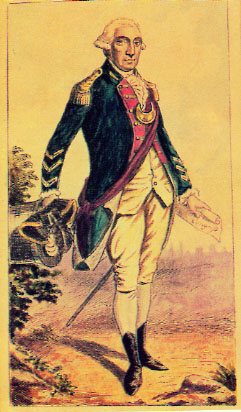
James Napper Tandy (National Museum of Ireland)
This communication, which was subsequently presented to Talleyrand, represented a significant coup for Coigly. Not alone did it reflect the co-operation amongst the British radicals, but it gave an exaggerared appearance of strength and preparation which the priest could exploit in his attempt to secure French military assistance.
Armed with the address, Coigly and Arthur MacMahon, the Presbyterian minister from Holywood, left London for Paris. This journey is outlined in detail in Coigly’s Life, but any suggestion of its seditious purpose is assiduously avoided. He does, however acknowledge, that an attempted arrest had forced him to dress á la militaire. In a similar way, he make little of his meeting with Admiral de Winter on board the fleet at the Texel in the pro-French Batavian Republic (Holland); perhaps this absence of comment may have been intended to imply an innocence of the intended destination of this invasionary force.
‘Petty little intrigue’ in Paris
In Paris, as in Ireland, the United Irish ranks were divided. Wolfe Tone and Edward Lewins led the moderate faction, while the radicals took their lead from the veteran campaigner, James Napper Tandy. Lewins was recognised as the official United Irish delegate in the city, but his authority had been challenged since Tandy’s arrival from America in June 1797. He had criticised the apparent inactivity of Lewins and Tone, and their position was further weakened by the sudden death, in September, of General Lazare Hoche. Encouraged by the arrival of Coigly, Tandy summoned the two before a mock tribunal; Lewins refused to attend, but Tone who did dismissed it as a ‘petty little intrigue’. Having failed to displace the moderates, Coigly was dispatched to Dublin in order to secure Lewins’s replacement by a more earnest representative. This would be his final assignment.
Coigly crossed to London via Hamburg where he stayed some days with Samuel Turner of Newry, the United Irish representative in the city. Unknown to the priest, Turner had become an informer and Whitehall was well acquainted with the details of his mission in Britain. Coigly’s every movement was monitored by Bow Street runners, and far from being the cunning master of disguise described by Froude, the priest was conspicuous in his military uniform, complete with red cape.
Coigly stayed with the Binns brothers in London and was a frequent visitor at the home of Valentine Lawless. During this short stay, he attended a meeting of the newly formed national committee of the United Britons, on 5 January 1798, and took a fraternal address to the United Irishmen. Together with Benjamin Binns and another member of the committee, William Bailey, he crossed to Ireland. The address was presented to Henry Jackson and it was subsequently discussed at length by a United Irish national committee and circulated to the provinces. The high level of publicity given to it by the radicals reflected their dual intention of spurring the moderates to action and of distracting Whitehall from their Irish activities. Meanwhile, Coigly met with Lord Edward Fitzgerald. The outcome of this meeting appears to have been a commission to replace Lewins at Paris by Arthur O’Connor.
Mission to France
Coigly returned to London in the first week of February. He met with the north of England radicals en route, informing them that this would be his last visit; if he returned it would be to see the Tree of Liberty planted in Manchester. In London he met with O’Connor at the home of Valentine Lawless where they planned their mission to France. While all three subsequently claimed that this had been their first meeting, they were already well acquainted. Coigly is likely to have collaborated with O’Connor in the Antrim campaign of the previous year and Lawless could hardly have avoided meeting him in London radical circles.
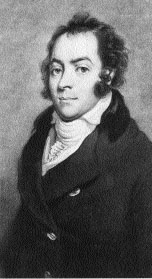
Arthur O’Connor
Final preparations were made for this critical mission to France. Three weeks were spent supervising the publication of propaganda at Fenwick’s Courier works and attending radical meetings. On one occasion, Dr Thomas Crossfield, of the London Corresponding Society, entrusted Coigly with an address from ‘The Secret Committee of England’ to the Directory of France. This was a high-sounding missive, which according to Froude would appear to any ‘solid Englishmen’ as the production of a lunatic Yet, in Coigly’s hand this address, with its lofty claims could have been the ace.
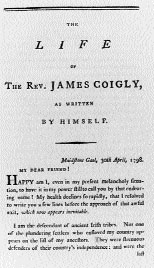
The United Irish interest in British radicalism had been motivated principally by their desire to attract French military assistance to Ireland and, towards this end, the promised welcome for the ‘hero of Italy’ [Bonaparte] could have been most effective.
The mission to France proved disastrous. Since his arrival at Christmas, O’Connor’s high profile amongst the city’s Whigs had roused the suspicion of the authorities, who delighted in the prospect of implicating so prominent a friend of the opposition. Even in this attempted flight, O’Connor’s arrogance attracted suspicion; not content to allow Coigly to pass as ‘Captain Jones’, he took the superior title of ‘Colonel Morris’. Coupled with this, there was the ludicrous spectacle of this would-be emissary, complete with mountains of luggage, mahogany trunks, hams and other provisions attempting to secure a ferry to France at the height of an invasion scare.
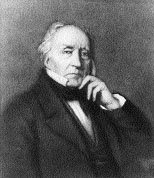
John Binns, a key figure in the republican transformation of the London Corresponding Society.
Not surprisingly, the party of five—Coigly, John Binns, O’Connor, his servant O’Leary and John Allen, a Dublin United Irishman—were apprehended at the King’s Head, Margate, early on 28 February 1798. With characteristic sang froid, Coigly asked to finish his breakfast, a request granted by the arresting officers, Fugion and Rivitt, who had trailed him since his return to London in January.
The arrests generated great excitement. In government circles there was delight at the prospect of discrediting the opposition, but the radicals were justifiably anxious. In Paris, Tone expressed amazement; he had little sympathy for Coigly, but dreaded to think of a man of O’Connor’s’ talents, being caught in such extraordinary circumstances. In Dublin, however, McNally reported that the moderates were not sorry to have the ‘impetuous’ O’Connor out of the way. The newspapers were filled with accounts of their arrest and the five were reported to be in possession ‘a traiterous correspondence’ between Ireland, France and England. Fortunately for them, O’Leary with great foresight disposed of the most significant documents in the privy of the King’s Head. Since these included O’Connor’s Paris commission, it was little wonder that Fitzgerald expessed delight that he had ‘nothing odd with him but twelve hundred guineas’.
March 1798 arrests
The prisoners were brought before the Privy Council, which included both Pitt and the Duke of Portland: O’Connor’s mahogany trunk was opened, revealing little of importance, save for a code which made sense only after Lord Edward’s later arrest. In spite of this disappointment, the government resolved to act. On 12 March, almost the entire Leinster provincial committee was arrested in a raid on Oliver Bond’s house, along with members of its executive, in what Tone called ‘the most terrible blow…a triumph for Fitzgibbon’. This was followed by the capture of the leading English radicals in swoops in Manchester, Leicester and Birmingham on 18 and 19 April.
The difficulty for government was that most of the evidence against the Margate five consisted of informers’ reports which would be inadmissible in court without revealing the identity of Turner, McNally and other valuable sources. Accordingly, the trial was delayed until mid-May: in the interim a frantic search for ‘such evidence of guilt as will suffice to convict them in the ordinary course of law’ was mounted. Government intelligence increased; the confessions of Robert Gray confirmed the prisoners’ guilt; there were rumours that O’Connor offered to turn King’s evidence; attempts were made to use Coigly’s confessor to secure additional information; Coigley himself was offered his life if only he would implicate O’Connor.
Prejudice of the court
Such was the urgency of the Dublin administration that the trial began on 20 May before sufficient evidence had been assembled. The entire case rested on Dr Crossfield’s address which had been found in the pocket of Coigly’s coat. From the outset the prejudice of the court was evident. It soon emerged that Revd. Arthur Young, son of the famed traveller, had attempted to sway prospective jurors, stressing the necessity ‘for the security of the realm’ that ‘the felons should swing’ irrespective of their innocence or guilt. O’Connor, who had attempted to bribe the jailers, mounted a spirited defence, to the point where he was reprimanded by Justice Buller for prejudicing the case of the other defendants. In any event, his ability to call Charles James Fox and the Whig establishment in his defence was sufficient to dazzle the jury and assure his acquittal.
Against Coigly, the Crown called Frederick Dutton, a notorious criminal and perjurer from Newry who may have been recommended by Samuel Turner. His principal task was to identify the priest’s hand writing and he duly obliged, claiming to have seen it on a lottery ticket at Dundalk. Having performed this task, he was awarded £50 expenses, the equivalent of almost two years wages. Coigly was hardly allowed a defence and what representation he had was made possible only by the generosity of Valentine Lawless. Two defence witnesses, Bernard Coyle and Valentine Derry were requested, but neither of these were called. The odds were stacked against the priest; his companions were acquitted, but he was found guilty on the most slender evidence, the presence of the letter in his coatpocket.
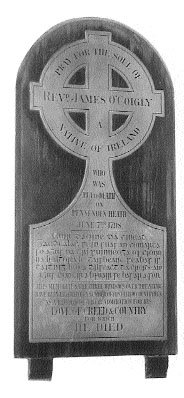
Coigley’s memorial at Maidstone.
Sentencing him to death, Justice Buller praised the mildness and clemency of the administration. At that point Coigly took a pinch of snuff and said ‘ahem!’
Pyrrhic victory for administration
The conviction was a pyrrhic victory for the administration. O’Connor, the important prisoner, had been acquitted, the government had failed in its effort to implicate the opposition and the unsatisfactory nature of the trial had made a martyr of the Armagh priest. Nowhere was the anger more keenly felt than in Dublin Castle and John Fitzgibbon cursed Young’s ‘foolish rhapsody’ which Edward Cooke believed had saved the lives of the prisoners who were acquitted. The satisfaction of Whig opposition, however, was short-lived, since O’Connor‘s admission of guilt before the Irish parliamentry Committees of Secrecy the following August exposed the folly of their court appearances.
In the interim, the opposition press exploited the spectacle of Coigly’s execution. In a skilfully directed campaign every effort was made to present the dignity and integrity of an innocent victim. In this choreographed drama Coigly played his part to perfection; even on the scaffold he denounced the ‘church and king mob’ of his native county. Tone, receiving the news of Coigly’s execution exclaimed, ‘nothing in his life became him like the leaving of it’.
In Ireland Coigly’s death was overtaken by events. Rebellion had broken out on 23 May and in those critical circumstances news of the priest’s death made little impact. Recent years have seen an unprecedented level of scholarship devoted to the 1790s, re-examining the legacy of the United Irishmen and their ambitious plan to join Catholic, Protestant and Dissenter in an inclusive republic, including the role of James Coigly, a forgotten champion of that enterprise.
Dáire Keogh lectures in Irish history at St Patrick’s College, Drumcondra.
Further reading:
D. Keogh, A Patriot Priest: the life of the Revd. James Coigley, 1761-1798 (Cork 1998).
M. Elliott, Partners in Revolution: the United Irishmen and France (Yale 1982 & 1998).
















